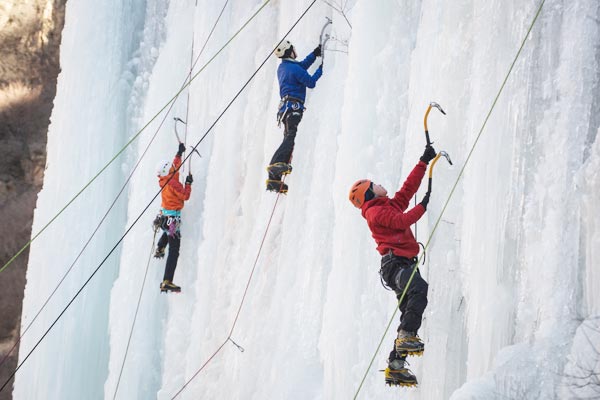Ice climbers reaching new heights
By Erik Nilsson and Yang Yang ( China Daily ) Updated: 2015-01-10 07:28:49
 |
|
Ice climbing enthusiasts descend from a 30-meter-high ice wall in suburban Beijing's Yunmeng Valley. Photos by Wei Xiaohao / China Daily |
The country's plentiful ice-climbing destinations are attracting overseas devotees.
"China is a frontier for all forms of climbing, including a large area that has good ice-forming conditions," iceclimbingjapan's Ed Hannam explains.
"Logistically, China is difficult. But this helps keep numbers of climbers small and avoid the crowding some other ice destinations have."
The company's China climbs focus on Sichuan. "Climbing (in China) is excellent - though a serious undertaking, requiring a degree of full expedition preparation," Hannam explains. "The ice routes themselves are among the best in the world - spectacular, large, good ice and a full spectrum of difficulty. In some areas, access is simple. In other places, access is a major factor."
China's climbing ecosystem is distinctive, he says. "The culture that surrounds ice climbing reflects that. It's still frontier stuff with almost no industry around it. That sets it apart from other popular ice destinations."
Safety remains a concern. Hannam explains his group takes fewer risks in the country than overseas.
"Any form of rescue is pretty distant, which increases the risk level. Dangers acceptable elsewhere are less so in China. China also doesn't have dedicated mountain-rescue organizations to deal with climbing accidents in the way Europe, Japan and the United States do," he says.
"The dangers are the usual ones - falling rocks and ice, the cold, sharp equipment, stupid decisions, etc. Objective hazards are perhaps higher in China where the ice is climbed less. So some of the dangers are not (publicized) through a climbing community like they are elsewhere."
But He believes the risks are not only surmountable but also conjure the allure.
"Ice walls seduce you to subjugate them. Humans are compelled to conquer nature," he says.
"And people who master climbing discover it's astonishing."
|
|
|
|
|
|
|
|

























 Raymond Zhou:
Raymond Zhou: Pauline D Loh:
Pauline D Loh: Hot Pot
Hot Pot Eco China
Eco China China Dream
China Dream China Face
China Face






